Ray Charles
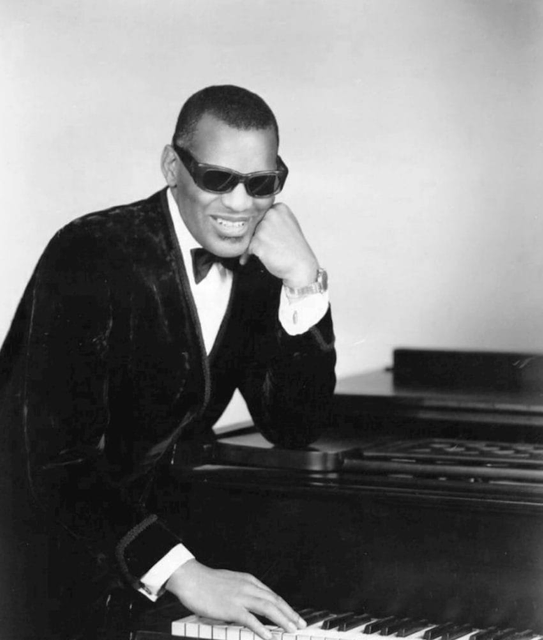
Ray Charles

Ray Charles | |
|---|---|
| Background information | |
| Birth name | Ray Charles Robinson[1] |
| Born | (1930-09-23)September 23, 1930 Albany, Georgia, U.S.[2] |
| Died | June 10, 2004(2004-06-10)(aged 73) Beverly Hills, California, U.S. |
| Genres | |
| Occupation(s) |
|
| Instruments |
|
| Years active | 1947–2004 |
| Labels |
|
| Associated acts |
|
| Website | raycharles.com [103] |
Ray Charles Robinson (September 23, 1930 – June 10, 2004), professionally known as simply Ray Charles, was an American singer, songwriter, musician, and composer. Among friends and fellow musicians he preferred being called "Brother Ray". He was often referred to as "The Genius".[3][4] Charles started losing his vision at the age of 5, and by 7 he was blind.
He pioneered the soul music genre during the 1950s by combining blues, rhythm and blues, and gospel styles into the music he recorded for Atlantic.[5][6][7] He contributed to the integration of country music, rhythm and blues, and pop music during the 1960s with his crossover success on ABC Records, notably with his two Modern Sounds albums.[8][9][10] While he was with ABC, Charles became one of the first black musicians to be granted artistic control by a mainstream record company.[6] Charles placed multiple singles and albums in the Top 10 of the Top 40 on various Billboard charts: 44 on the US R&B singles charts, 11 on the Hot 100 singles charts, 2 on the US Country singles charts, 8 on the Billboard 200 album charts, and one on the US Country Album charts.
Charles cited Nat King Cole as a primary influence, but his music was also influenced by Louis Jordan and Charles Brown.[11] He became friends with Quincy Jones. Their friendship lasted until the end of Charles's life. Frank Sinatra called Ray Charles "the only true genius in show business", although Charles downplayed this notion.[12]
In 2002, Rolling Stone ranked Charles number ten on its list of the "100 Greatest Artists of All Time",[3] and number two on their November 2008 list of the "100 Greatest Singers of All Time".[13] Billy Joel said, "This may sound like sacrilege, but I think Ray Charles was more important than Elvis Presley".[14]
Ray Charles | |
|---|---|
| Background information | |
| Birth name | Ray Charles Robinson[1] |
| Born | (1930-09-23)September 23, 1930 Albany, Georgia, U.S.[2] |
| Died | June 10, 2004(2004-06-10)(aged 73) Beverly Hills, California, U.S. |
| Genres | |
| Occupation(s) |
|
| Instruments |
|
| Years active | 1947–2004 |
| Labels |
|
| Associated acts |
|
| Website | raycharles.com [103] |
Early life and education
Ray Charles Robinson[1] was the son of Bailey Robinson, a laborer, and Aretha (or Reatha) Williams. His mother was a teenage orphan making a living as a sharecropper. They lived in Greenville, Florida with Robinson's father and his wife, Mary Jane Robinson. The Robinson family had informally adopted Aretha, and she took the surname Robinson. When she became pregnant by Bailey, incurring scandal, she left Greenville late in the summer of 1930 to be with family members in Albany, Georgia for the baby's birth, after which mother and child returned to Greenville. She and Mary Jane then shared in Ray's upbringing. He was deeply devoted to his mother and later recalled her perseverance, self-sufficiency, and pride as guiding lights in his life. His father abandoned the family, left Greenville, and married another woman elsewhere.[15]
In his early years, Charles showed an interest in mechanical objects and would often watch his neighbors working on their cars and farm machinery. His musical curiosity was sparked at Wylie Pitman's Red Wing Cafe, at the age of three, when Pitman played boogie woogie on an old upright piano; Pitman subsequently taught Charles how to play the piano. Charles and his mother were always welcome at the Red Wing Cafe and even lived there when they were in financial distress.[11] Pitman would also care for Ray's younger brother George, to take some of the burden off their mother. George drowned in his mother's laundry tub when he was four years old.[11][16]
Charles started to lose his sight at the age of four[4] or five,[17] and was blind by the age of seven, apparently as a result of glaucoma.[18] Destitute, uneducated, and mourning the loss of her younger son, Aretha (or Reatha) Robinson used her connections in the local community to find a school that would accept a blind African-American pupil. Despite his initial protest, Charles attended school at the Florida School for the Deaf and the Blind in St. Augustine from 1937 to 1945.[19]
Charles further developed his musical talent at school[18] and was taught to play the classical piano music of J.S. Bach, Mozart and Beethoven. His teacher, Mrs. Lawrence, taught him how to use braille music, a difficult process that requires learning the left hand movements by reading braille with the right hand and learning the right hand movements by reading braille with the left hand, and then combining the two parts. While Charles was happy to play classical music, he was more interested in the jazz, blues, and country music he heard on the radio.[19] [] On Fridays, the South Campus Literary Society held assemblies at which Charles would play piano and sing popular songs. On both Halloween and on George Washington's birthday, the black department of the school held socials at which Charles would play. It was here he established "RC Robinson and the Shop Boys" and sang his own arrangement of "Jingle Bell Boogie". During this time, he performed on WFOY radio in St. Augustine.[19]
Ray Charles' mother died in the Spring of 1944, when Ray was 14. Her death came as a shock to him; he later said the deaths of his brother and mother were "the two great tragedies" of his life. Charles returned to school after the funeral but was expelled in October for playing a prank on his teacher.[19]
Career
1945–1952: Florida, Los Angeles, Seattle and San Bernardino CA first hits
He joined the musicians' union in the hope that it would help him get work. He befriended many union members, but others were less kind to him because he would monopolize the union hall's piano, since he did not have one at home. He started to build a reputation as a talented musician in Jacksonville, but the jobs did not come fast enough for him to construct a strong identity. He decided to leave Jacksonville and move to a bigger city with more opportunities.[22]
At age 16, Charles moved to Orlando, where he lived in borderline poverty and went without food for days. It was difficult for musicians to find work, as since World War II had ended there were no "G.I. Joes" left to entertain. Charles eventually started to write arrangements for a pop music band, and in the summer of 1947 he unsuccessfully auditioned to play piano for Lucky Millinder and his sixteen-piece band.[19]
In 1947, Charles moved to Tampa, where he had two jobs: one as a pianist for Charles Brantley's Honeydippers.[23]
In his early career, he modeled himself on Nat King Cole. His first four recordings—"Wondering and Wondering", "Walking and Talking", "Why Did You Go?" and "I Found My Baby There"—were allegedly made in Tampa, although some discographies claim he recorded them in Miami in 1951 or Los Angeles in 1952.[19]
Charles had always played piano for other people, but he was keen to have his own band. He decided to leave Florida for a large city, and, considering Chicago and New York City too big, followed his friend Gossie McKee to Seattle, Washington, in March 1948, knowing that the biggest radio hits came from northern cities.[19][24] Here he met and befriended, under the tutelage of Robert Blackwell, a 15-year-old Quincy Jones.[25]
He started playing the one-to-five A.M. shift at the Rocking Chair with his band McSon Trio, which featured McKee on guitar and Milton Garrett on bass. Publicity photos of the trio are some of the earliest known photographs of Charles. In April 1949, he and his band recorded "Confession Blues", which became his first national hit, soaring to the second spot on the Billboard R&B chart.[19] While still working at the Rocking Chair, he also arranged songs for other artists, including Cole Porter's "Ghost of a Chance" and Dizzy Gillespie's "Emanon".[22] After the success of his first two singles, Charles moved to Los Angeles in 1950, and spent the next few years touring with the blues musician Lowell Fulson as his musical director.[4]
In 1950, his performance in a Miami hotel impressed Henry Stone, who went on to record a Ray Charles Rockin' record (which never became particularly popular). During his stay in Miami, Charles was required to stay in the segregated but thriving black community of Overtown. Stone later helped Jerry Wexler find Charles in St. Petersburg.[26]
After signing with Swing Time Records, he recorded two more R&B hits under the name Ray Charles: "Baby, Let Me Hold Your Hand" (1951), which reached number five, and "Kissa Me Baby" (1952), which reached number eight. Swing Time folded the following year, and Ahmet Ertegün signed him to Atlantic.[18]
1952–1959: Atlantic Records
In June 1952, Atlantic bought Charles's contract for $2,500 (US$23,587 in 2018 dollars[21]).[27][28] His first recording session for Atlantic ("The Midnight Hour"/"Roll with My Baby") took place in September 1952, although his last Swing Time release ("Misery in My Heart"/"The Snow Is Falling") would not appear until February 1953.
In 1953, "Mess Around" became his first small hit for Atlantic; during the next year he had hits with "It Should've Been Me" and "Don't You Know".[28] He also recorded the songs "Midnight Hour" and "Sinner's Prayer".
Late in 1954, Charles recorded "I've Got a Woman". The lyrics were written by bandleader Renald Richard. Charles claimed the composition. They later admitted that the song went back to The Southern Tones' "It Must Be Jesus" (1954). It became one of his most notable hits, reaching number two on the R&B chart.[28] "I've Got a Woman" combined gospel, jazz, and blues. In 1955, he had hits with "This Little Girl of Mine" and "A Fool for You". In upcoming years, he scored with "Drown in My Own Tears" and "Hallelujah I Love Her So". In 1959, "What'd I Say" reached No. 6 on the Billboard Pop chart and No. 1 on the Billboard R&B chart.[28]
He also recorded jazz, such as The Great Ray Charles (1957) and worked with vibraphonist Milt Jackson, releasing Soul Brothers in 1958 and Soul Meeting in 1961. By 1958, he was not only headlining black venues such as the Apollo Theater in New York, but also bigger venues such as Carnegie Hall and the Newport Jazz Festival where his first live album was recorded in 1958. He hired a female singing group, The Cookies, and renamed them The Raelettes. In 1958, Charles and The Raelettes performed for the famed Cavalcade of Jazz concert produced by Leon Hefflin Sr. held at the Shrine Auditorium on August 3. The other headliners were Little Willie John, Sam Cooke, Ernie Freeman, and Bo Rhambo. Sammy Davis Jr. was there to crown the winner of the Miss Cavalcade of Jazz beauty contest. The event featured the top four prominent disc jockey of Los Angeles.[29][30] On October 1, 1959 Raelette Margie Hendricks gave birth to Ray's son Charles Wayne Hendricks.[31]
1959–1971: Crossover success
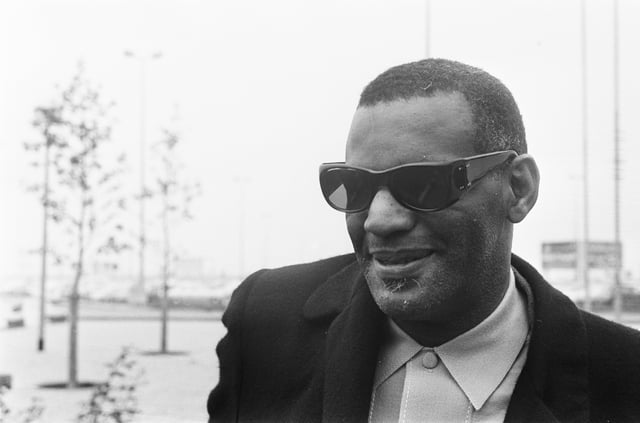
Charles in 1968
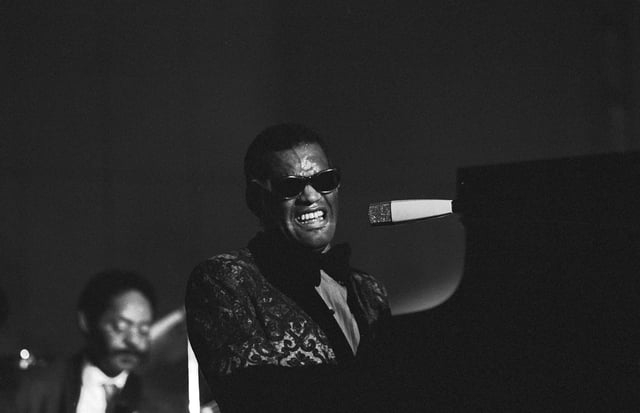
Charles in 1971
Charles reached the pinnacle of his success at Atlantic with the release of "What'd I Say", which combined gospel, jazz, blues and Latin music. Charles said he wrote it spontaneously while he was performing in clubs with his band. Despite some radio stations banning the song because of its sexually suggestive lyrics, the song became his first top ten pop record.[32]
Later in 1959, he released his first country song (a cover of Hank Snow's "I'm Movin' On") and recorded three more albums for the label: a jazz record (The Genius After Hours, 1961); a blues record (The Genius Sings the Blues, 1961); and a big band record (The Genius of Ray Charles which was his first Top 40 album, peaking at number 17.
His contract with Atlantic expired in 1959, and several big labels offered him record deals; choosing not to renegotiate his contract with Atlantic, he signed with ABC-Paramount in November 1959.[33] He obtained a more liberal contract than other artists had at the time, with ABC offering him a $50,000 (US$429,737 in 2018 dollars[21]) annual advance, higher royalties than before and eventual ownership of his master tapes—a very valuable and lucrative deal at the time.[34] During his Atlantic years, Charles had been heralded for his inventive compositions, but by the time of the release of the largely instrumental jazz album Genius + Soul = Jazz (1960) for ABC's subsidiary label Impulse!, he had given up on writing to follow his eclectic impulses as an interpreter.[32]
With "Georgia on My Mind", his first hit single for ABC-Paramount in 1960, Charles received national acclaim and four Grammy Awards, including two for "Georgia on My Mind" (Best Vocal Performance Single Record or Track, Male, and Best Performance by a Pop Single Artist). Written by Stuart Gorrell and Hoagy Carmichael, the song was Charles's first work with Sid Feller, who produced, arranged and conducted the recording.[32][35]
Charles earned another Grammy for the follow-up "Hit the Road Jack", written by R&B singer Percy Mayfield.[36]
By late 1961, Charles had expanded his small road ensemble to a big band, partly as a response to increasing royalties and touring fees, becoming one of the few black artists to cross over into mainstream pop with such a level of creative control.[32][37] This success, however, came to a momentary halt during a concert tour in November 1961, when a police search of Charles's hotel room in Indianapolis, Indiana, led to the discovery of heroin in the medicine cabinet. The case was eventually dropped, as the search lacked a proper warrant by the police, and Charles soon returned to music.[37]
In the early 1960s, on the way from Louisiana to Oklahoma City, Charles faced a near-death experience when the pilot of his plane lost visibility, as snow and his failure to use the defroster caused the windshield of the plane to become completely covered in ice. The pilot made a few circles in the air before he was finally able to see through a small part of the windshield and land the plane. Charles placed a spiritual interpretation on the event, claiming that "something or someone which instruments cannot detect" was responsible for creating the small opening in the ice on the windshield which enabled the pilot to land the plane safely.[11]
The 1962 album Modern Sounds in Country and Western Music and its sequel, Modern Sounds in Country and Western Music, Vol. 2, helped to bring country music into the musical mainstream. Charles's version of the Don Gibson song "I Can't Stop Loving You" topped the Pop chart for five weeks, stayed at number 1 on the R&B chart for ten weeks, and gave him his only number-one record in the UK. In 1962, he founded his record label, Tangerine, which ABC-Paramount promoted and distributed.[11] [] [19] [] He had major pop hits in 1963 with "Busted" (US number 4) and Take These Chains from My Heart (US number 8).[38] In 1964 Margie Hendricks was kicked out of The Raelettes after a big argument.
In 1965, Charles's career was halted once more after he was arrested for a third time for possession of heroin. He agreed to go to rehab to avoid jail time and eventually kicked his habit at a clinic in Los Angeles. After spending a year on parole, Charles reappeared in the charts in 1966 with a series of hits composed with Ashford & Simpson, including the dance number "I Don't Need No Doctor" and "Let's Go Get Stoned", which became his first number-one R&B hit in several years. His cover version of "Crying Time", originally recorded by country singer Buck Owens, reached number 6 on the pop chart and helped Charles win a Grammy Award the following March. In 1967, he had a top-twenty hit with another ballad, "Here We Go Again".[39]
1971–1983: Commercial decline

Charles meeting with President Richard Nixon, 1972 (photo by Oliver F. Atkins)
Charles's renewed chart success, however, proved to be short lived, and by the 1970s his music was rarely played on radio stations. The rise of psychedelic rock and harder forms of rock and R&B music had reduced Charles' radio appeal, as did his choosing to record pop standards and covers of contemporary rock and soul hits, since his earnings from owning his masters had taken away the motivation to write new material. Charles nonetheless continued to have an active recording career. Most of his recordings between 1968 and 1973 evoked strong reactions: people either liked them a lot or strongly disliked them.[18] His 1972 album A Message from the People included his unique gospel-influenced version of "America the Beautiful" and a number of protest songs about poverty and civil rights. Charles was often criticized for his version of "America the Beautiful" because it was very drastically changed from the song's original version. On July 14, 1973 Margie Hendricks died at 38 years old from a heroin overdose which shocked Ray.
In 1974, Charles left ABC Records and recorded several albums on his own label, Crossover Records. A 1975 recording of Stevie Wonder's hit "Living for the City" later helped Charles win another Grammy. In 1977, he reunited with Ahmet Ertegün and re-signed to Atlantic Records, for which he recorded the album True to Life, remaining with his old label until 1980. However, the label had now begun to focus on rock acts, and some of their prominent soul artists, such as Aretha Franklin, were starting to be neglected. In November 1977 he appeared as the host of the NBC television show Saturday Night Live.[40]
In April 1979, his version of "Georgia on My Mind" was proclaimed the state song of Georgia, and an emotional Charles performed the song on the floor of the state legislature.[18] Although he had notably supported the American Civil Rights Movement and Martin Luther King Jr. in the 1960s, Charles was criticized for performing at the Sun City resort in South Africa in 1981, during an international boycott protesting that country's apartheid policy. He later defended his choice of performing there after insisting that the audience of black and white fans would integrate while he was there.[18]
1983–2004: Later years

Charles with President Ronald Reagan and First Lady Nancy Reagan, 1984
In 1983, Charles signed a contract with Columbia. He recorded a string of country albums and had hit singles in duets with singers such as George Jones, Chet Atkins, B. J. Thomas, Mickey Gilley, Hank Williams Jr., Dee Dee Bridgewater ("Precious Thing") and his longtime friend Willie Nelson, with whom he recorded "Seven Spanish Angels".
In 1985, Charles participated in the famous musical recording and video "We Are the World", a charity single recorded by the supergroup United Support of Artists (USA) for Africa.
Before the release of his first album for Warner, Would You Believe, Charles made a return to the R&B charts with a cover of the Brothers Johnson's "I'll Be Good to You", a duet with his lifelong friend Quincy Jones and the singer Chaka Khan, which hit number one on the R&B chart in 1990 and won Charles and Khan a Grammy for their duet. Prior to this, Charles returned to the pop charts with "Baby Grand", a duet with the singer Billy Joel. In 1989, he recorded a cover of the Southern All Stars' "Itoshi no Ellie" for a Japanese TV advertisement for the Suntory brand, releasing it in Japan as "Ellie My Love", where it reached No. 3 on its Oricon chart.[41] In the same year he was a special guest at the Arena di Verona during the tour promoting Oro Incenso & Birra of the Italian singer Zucchero Fornaciari.
In 2001–02, Charles appeared in commercials for the New Jersey Lottery to promote its campaign "For every dream, there's a jackpot".[42]
In 2003, he headlined the White House Correspondents Dinner in Washington, D.C., attended by President George W. Bush, Laura Bush, Colin Powell and Condoleezza Rice.[43]
Also in 2003, Charles presented Van Morrison with Morrison's award upon being inducted in the Songwriters Hall of Fame, and the two sang Morrison's song "Crazy Love" (the performance appears on Morrison's 2007 album The Best of Van Morrison Volume 3). In 2003, Charles performed "Georgia on My Mind" and "America the Beautiful" at a televised annual banquet of electronic media journalists held in Washington, D.C. His final public appearance was on April 30, 2004, at the dedication of his music studio as a historic landmark in Los Angeles.[18]
Death
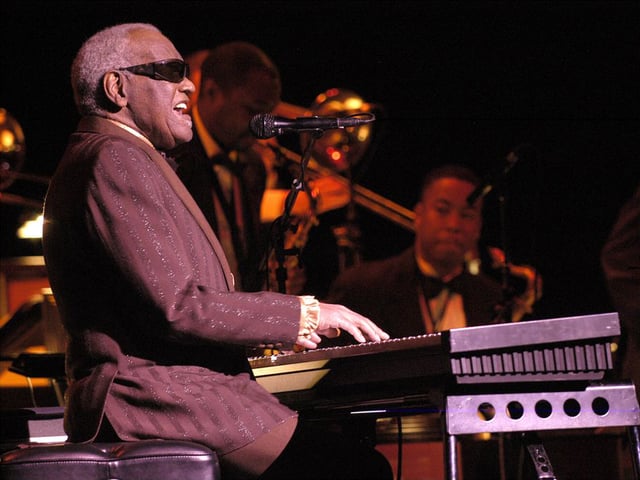
Charles at the 2003 Montreal International Jazz Festival, one of his last public performances
In 2003, Charles had successful hip replacement surgery and was planning to go back on tour, until he began suffering from other ailments. He died at his home in Beverly Hills, California of complications resulting from liver failure,[4] on June 10, 2004, at the age of 73.[44] His funeral took place on June 18, 2004, at the First AME Church in Los Angeles with numerous musical figures in attendance.[45] B. B. King, Glen Campbell, Stevie Wonder and Wynton Marsalis each played a tribute at the funeral.[46] He was interred in the Inglewood Park Cemetery.
His final album, Genius Loves Company, released two months after his death, consists of duets with admirers and contemporaries: B. B. King, Van Morrison, Willie Nelson, James Taylor, Gladys Knight, Michael McDonald, Natalie Cole, Elton John, Bonnie Raitt, Diana Krall, Norah Jones and Johnny Mathis. The album won eight Grammy Awards, including Best Pop Vocal Album, Album of the Year, Record of the Year and Best Pop Collaboration with Vocals (for "Here We Go Again", with Norah Jones), and Best Gospel Performance (for "Heaven Help Us All", with Gladys Knight); he also received nods for his duets with Elton John and B. B. King. The album included a version of Harold Arlen's and E. Y. Harburg's "Over the Rainbow", sung as a duet with Johnny Mathis, which was played at Charles's memorial service.[46]
Personal life
Charles was married twice and had 12 children with nine different women. His first child, Evelyn, was born in 1949 to his companion, Louise Flowers. His first marriage was to Eileen Williams Robinson and lasted from July 31, 1951, until the following year, 1952.
His second marriage, to Della Beatrice Howard Robinson (called "Bea" by Charles), began on April 5, 1955 and lasted 22 years. Their first child together, Ray Jr., was born in 1955. Charles was not in town for the birth because he was playing a show in Texas. The couple had two more children, David (1958) and Robert (1960). Charles felt that his heroin addiction took a toll on Della during their marriage.[11]
Charles had a six-year-long affair with Margie Hendricks, one of the original Raelettes, and in 1959 they had a son, Charles Wayne. His affair with Mae Mosley Lyles resulted in another daughter, Renee, born in 1961. In 1963, by Sandra Jean Betts, Ray Charles had a daughter, Sheila Raye Charles, a singer and songwriter who died of breast cancer on June 15, 2017.[47]
Substance abuse and legal problems
Charles first tried recreational drugs when he played in McSon Trio and was eager to try them as he thought they helped musicians create music and tap into their creativity. He later became addicted to heroin for sixteen years. He was first arrested in the 1950s, when he and his bandmates were caught backstage with loose marijuana and drug paraphernalia, including a burnt spoon, syringe, and needle. The arrest did not deter Charles's drug use, which only escalated as he became more successful and made more money.[19]
Charles was arrested again on a narcotics charge on November 14, 1961, while waiting in an Indiana hotel room before a performance. The detectives seized heroin, marijuana, and other items. Charles, then 31, said he had been a drug addict since the age of 16. The case was dismissed because of the manner in which the evidence was obtained,[48] but Charles's situation did not improve until a few years later.
In 1964, Charles was arrested for possession of marijuana and heroin.[19] Following a self-imposed stay[48] at St. Francis Hospital in Lynwood, California, he received five years' probation for his crime. Charles responded to the saga of his drug use and reform with the songs "I Don't Need No Doctor", "Let's Go Get Stoned", and the release of Crying Time, his first album since having kicked his heroin addiction in 1966.[49][50]
After being caught with heroin at Logan Airport, Charles was sent to McLean Hospital “by a forgiving judge.”[51]
Other interests
In 2001, Morehouse College honored Charles with the Candle Award for Lifetime Achievement in Arts and Entertainment,[55] and later that same year granted him an honorary doctor of humane letters.[56] Charles donated $2 million to Morehouse "to fund, educate and inspire the next generation of musical pioneers."[56]
In 2010, a $20 million, 76,000 sq ft (7,100 m2) facility named the Ray Charles Performing Arts Center and Music Academic Building, opened at Morehouse.[57]
Legacy
Influence on music industry
Charles possessed one of the most recognizable voices in American music. In the words of musicologist Henry Pleasants:
Sinatra, and Bing Crosby before him, had been masters of words. Ray Charles is a master of sounds. His records disclose an extraordinary assortment of slurs, glides, turns, shrieks, wails, breaks, shouts, screams and hollers, all wonderfully controlled, disciplined by inspired musicianship, and harnessed to ingenious subtleties of harmony, dynamics and rhythm... It is either the singing of a man whose vocabulary is inadequate to express what is in his heart and mind or of one whose feelings are too intense for satisfactory verbal or conventionally melodic articulation. He can't tell it to you. He can't even sing it to you. He has to cry out to you, or shout to you, in tones eloquent of despair—or exaltation. The voice alone, with little assistance from the text or the notated music, conveys the message.[58]
Pleasants continues, "Ray Charles is usually described as a baritone, and his speaking voice would suggest as much, as would the difficulty he experiences in reaching and sustaining the baritone's high E and F in a popular ballad. But the voice undergoes some sort of transfiguration under stress, and in music of gospel or blues character he can and does sing for measures on end in the high tenor range of A, B flat, B, C and even C sharp and D, sometimes in full voice, sometimes in an ecstatic head voice, sometimes in falsetto. In falsetto he continues up to E and F above high C. On one extraordinary record, 'I'm Going Down to the River'...he hits an incredible B flat...giving him an overall range, including the falsetto extension, of at least three octaves."
His style and success in the genres of rhythm and blues and jazz had an influence on a number of highly successful artists, including, as Jon Pareles has noted, Elvis Presley, Aretha Franklin, Stevie Wonder, Van Morrison, and Billy Joel.[59] Other singers who have acknowledged Charles' influence on their own styles include James Booker,[60] Steve Winwood,[61] Richard Manuel,[62] and Gregg Allman.[63] According to Joe Levy, a music editor for Rolling Stone, "The hit records he made for Atlantic in the mid-50's mapped out everything that would happen to rock 'n' roll and soul music in the years that followed".[32] Charles was also an inspiration to Pink Floyd member Roger Waters, who told the Turkish newspaper Hurriyet: "I was about 15. In the middle of the night with friends, we were listening to jazz. It was "Georgia on My Mind", Ray Charles's version. Then I thought 'One day, if I make some people feel only one-twentieth of what I am feeling now, it will be quite enough for me.'"[64]
Ray, a biopic portraying his life and career between the mid-1930s and 1979, was released in October 2004, starring Jamie Foxx as Charles. Foxx won the 2005 Academy Award for Best Actor for the role.
Awards and honors
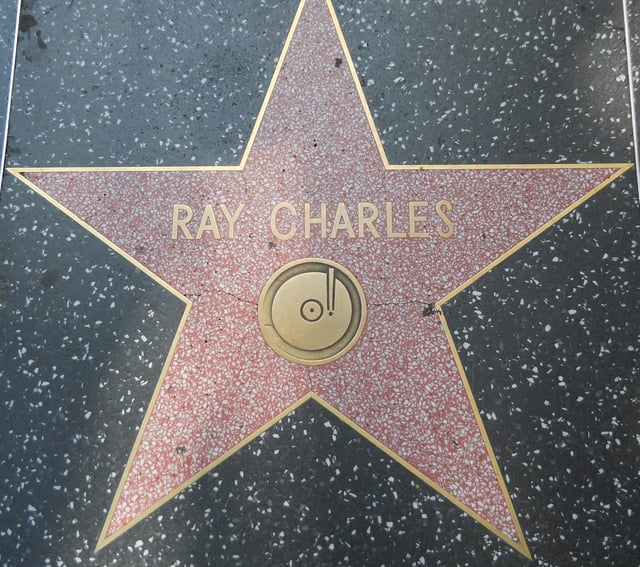
Star honoring Charles on the Hollywood Walk of Fame, at 6777 Hollywood Boulevard
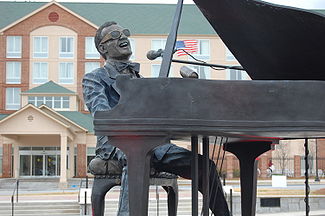
Statue by Andy Davis in Ray Charles Plaza in Albany, Georgia
In 1981 he was given a star on the Hollywood Walk of Fame and was one of the first inductees to the Rock & Roll Hall of Fame at its inaugural ceremony, in 1986.[67] He also received the Kennedy Center Honors in 1986.[68]
In 1987, he was awarded the Grammy Lifetime Achievement Award. In 1991, he was inducted to the Rhythm & Blues Foundation and was presented with the George and Ira Gershwin Award for Lifetime Musical Achievement during the 1991 UCLA Spring Sing.[69]
In 1990, he was given an honorable doctorate degree in fine arts by the University of South Florida.[70]
In 2003, Charles was awarded an honorary degree by Dillard University, and upon his death he endowed a professorship of African-American culinary history at the school, the first such chair in the nation.[73] A $20 million performing arts center at Morehouse College was named after Charles and was dedicated in September 2010.[74]
The United States Postal Service issued a forever stamp honoring Charles, as part of its Musical Icons series, on September 23, 2013.[75]
In 2015, Charles was inducted into the Rhythm and Blues Music Hall of Fame.[76]
In 2016, U.S. President Barack Obama said, "Ray Charles's version of 'America the Beautiful' will always be in my view the most patriotic piece of music ever performed—because it captures the fullness of the American experience, the view from the bottom as well as the top, the good and the bad, and the possibility of synthesis, reconciliation, transcendence."[77]
Contribution to civil rights movement
On March 15, 1961, shortly after the release of the hit song "Georgia on My Mind" (1960), the Albany, Georgia-born musician was scheduled to perform at a dance at Bell Auditorium in Augusta, but cancelled the show after learning from students of Paine College that the larger auditorium dance floor would be restricted to whites, while blacks would be obligated to sit in the Music Hall balcony. Charles left town immediately after letting the public know why he wouldn't be performing, but the promoter went on to sue Charles for breach of contract, and Charles was fined $757 in Fulton County Superior Court in Atlanta on June 14, 1962. The following year, Charles did perform at a desegregated Bell Auditorium concert together with his backup group the Raelettes on October 23, 1963,[78][79][80] as depicted in the 2004 film, Ray.[81] On December 7, 2007, Ray Charles Plaza was opened in Albany, Georgia, with a revolving, lighted bronze sculpture of Charles seated at a piano.[69]
The Ray Charles Foundation
Founded in 1986, the Ray Charles Foundation maintains the mission statement of financially supporting institutions and organizations in the research of hearing disorders.[82] Originally known as The Robinson Foundation for Hearing Disorders, it was renamed in 2006 and has provided financial donations to numerous institutions involved in hearing loss research and education.[83] The purpose of the foundation has been "to administer funds for scientific, educational and charitable purposes; to encourage, promote and educate, through grants to institutions and organizations, as to the causes and cures for diseases and disabilities of the hearing impaired and to assist organizations and institutions in their social educational and academic advancement of programs for the youth, and carry on other charitable and educational activities associated with these goals as allowed by law".[84]
Recipients of donations include Benedict College, Morehouse College, and other universities.[85] The foundation has taken action against donation recipients who do not use funds in accordance with its mission statement, such as the Albany State University, which was made to return a $3 million donation after not using the funds for over a decade.[86] The foundation houses its executive offices at the historic RPM International Building, originally the home of Ray Charles Enterprises and now also home to the Ray Charles Memorial Library on the first floor, which was founded on September 23, 2010 (what would have been his 80th birthday). The library was founded to "provide an avenue for young children to experience music and art in a way that will inspire their creativity and imagination", and is not open to the public without reservation, as the main goal is to educate mass groups of underprivileged youth and provide art and history to those without access to such documents.[87]
Loss of material
On June 25, 2019, The New York Times Magazine listed Ray Charles among hundreds of artists whose material was reportedly destroyed in the 2008 Universal fire.[88]
Discography
"I Got a Woman" (1954)
"What'd I Say" (1959)
"Georgia on My Mind" (1960)
"Hit the Road Jack" (1961)
"One Mint Julep" (1961)
"Unchain My Heart" (1961)
"I Can't Stop Loving You" (1962)
Filmography
Film
| Year | Title | Role | Notes |
|---|---|---|---|
| 1961 | Swingin' Along | Himself | |
| 1965 | Ballad in Blue | Himself | |
| 1966 | The Big T.N.T. Show | Himself | Documentary film |
| 1980 | The Blues Brothers | Ray | Cameo appearance |
| 1989 | Limit Up | Julius | |
| 1990 | Listen Up: The Lives of Quincy Jones | Himself | Documentary |
| 1994 | Love Affair | Himself | Cameo appearance |
| 1996 | Spy Hard | Bus Driver | Cameo appearance |
| 1998 | New Yorkers 2 | Himself | Cameo appearance |
| 2000 | The Extreme Adventures of Super Dave | Himself | |
| 2000 | Blue's Big Musical Movie | G-Clef (voice) | Final film role before his death in 2004 |
| 2004 | Ray | Himself | Uncredited Archival footage |
Television
| Year | Title | Role | Notes |
|---|---|---|---|
| 1977 | Saturday Night Live | Himself (host) | Season 3, Episode 5 |
| 1987 | Who's the Boss | Himself | Episode: "Hit the Road, Chad" |
| 1987 | St. Elsewhere | Arthur Tibbits | Episode: "Jose, Can You See?" |
| 1987 | Moonlighting | Himself | Episode: "A Trip to the Moon" |
| 1994 | Ray Alexander: A Taste for Justice | Television movie | |
| 1994 | Wings | Himself | Episode: "A Decent Proposal" |
| 1997–1998 | The Nanny | Sammy | 4 episodes |